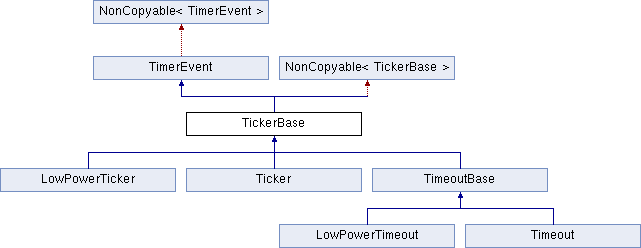- mbed
- TickerBase
A Ticker is used to call a function at a recurring interval. More...
#include <Ticker.h>

Public Member Functions | |
| template<typename F > | |
| MBED_FORCEINLINE void | attach (F &&func, float t) |
| Attach a function to be called by the Ticker, specifying the interval in seconds. More... | |
| void | attach_us (Callback< void()> func, us_timestamp_t t) |
| Attach a function to be called by the Ticker, specifying the interval in microseconds. More... | |
| void | attach (Callback< void()> func, std::chrono::microseconds t) |
| Attach a function to be called by the Ticker, specifying the interval in microseconds. More... | |
| void | detach () |
| Detach the function. More... | |
A Ticker is used to call a function at a recurring interval.
You can use as many separate Ticker objects as you require.
Example:
| MBED_FORCEINLINE void attach | ( | F && | func, |
| float | t | ||
| ) |
Attach a function to be called by the Ticker, specifying the interval in seconds.
The method forwards its arguments to attach_us() rather than copying them which may not be trivial depending on the callback copied. The function is forcibly inlined to not use floating-point operations. This is possible given attach_us() expects an integer value for the callback interval.
| func | pointer to the function to be called |
| t | the time between calls in seconds |
10ms rather than 0.01f. | void attach | ( | Callback< void()> | func, |
| std::chrono::microseconds | t | ||
| ) |
Attach a function to be called by the Ticker, specifying the interval in microseconds.
| func | pointer to the function to be called |
| t | the time between calls in micro-seconds |
| void attach_us | ( | Callback< void()> | func, |
| us_timestamp_t | t | ||
| ) |
Attach a function to be called by the Ticker, specifying the interval in microseconds.
| func | pointer to the function to be called |
| t | the time between calls in micro-seconds |
10ms rather than 10000.| void detach | ( | ) |
Detach the function.